Archives 2023
“This Is by No Means a Passive, Enervated Generation”
Editors: “The Tragedy of Man or Mankind?” – The late colleague of the National Theatre, Nina Király, had this repeatedly arising question as the title of her essay.[1] How do you, who directed The Tragedy for the sixth time within the framework of the international Madách project related to the bicentenary at the 10th Theatre Olympics, see this? It is surely not a coincidence that you chose this quote as the motto for MITEM 2021, and had it repeated several times in the current production as well: “Ah, in this tumult wild, What shall become of that self locked in me.” [“Óh, e zűr között / hová lesz énem zárt / egyénisége”]
A. V.: By addressing theatre students from eleven countries with our Madách project, it was settled on my part that I would stage The Tragedy as a drama of humanity. After all, these students, from Cairo to Toronto, from Tbilisi to Liverpool, represent humanity, the entirety of our modern world. The turning point in my interpretation of the drama came with my 2018 National Theatre production, in which I had several Lucifers appear. With this, I intended to illustrate that Adam’s intellectual aspect, his ’locked self’ is nowadays increasingly exposed to Satan’s temptation and the influence of evil which replicates through division. This is why I deemed it important that in this production being created within the shipyard hall of Hajógyári Sziget [Island], the motto chosen in 2021 should be uttered in every language, which already served as the cry of the attacked individuality in the late-romantic Madách’s drama.
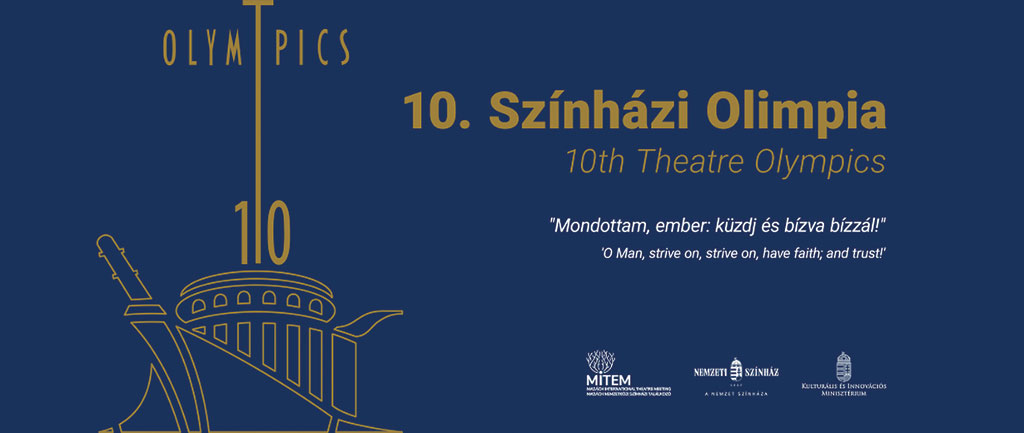
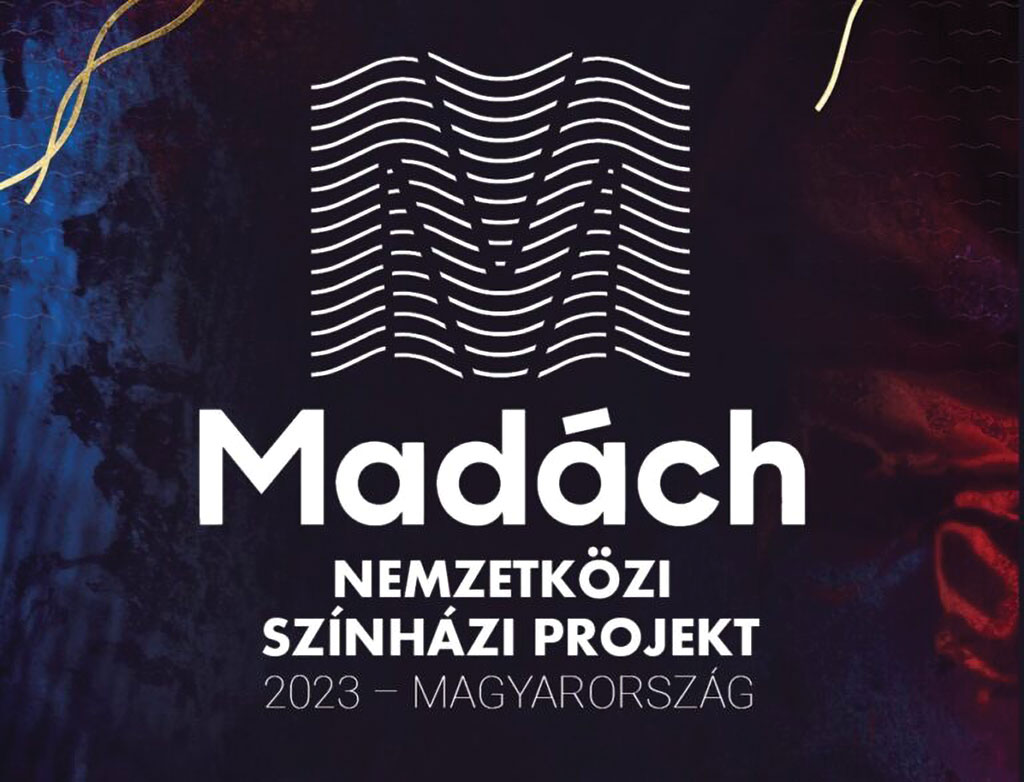
of the University of Theatre and Film Arts in Budapest, 2023 (source: nemzetiszinhaz.hu)
Editors: The Madách project, in which nearly two hundred university students participated alongside Hungarians, is also notable for having all the roles of The Tragedy portrayed by members of the same generation. If we play back the footage of this production a few years from now, we wonder what we will find the demeanor of this generation, the unique features of their perception of the world and the overall image which the camera recorded the moment they stepped onto the stage.
A. V.: I was pleased to discover that this is by no means a passive, enervated generation. At the age of twenty, they too pose the eternal question that arises from their age: ’Who am I?’ Just as Miklós Hubay expressed once in connection with Madách’s drama, they also prove that humanity still has ample reserves: “In biological terms, there is nothing wrong with humanity, the élan vital (’life force’) would still propel it like an arrow from a taut, well-tuned bow”[2]. If we are going to watch these film recordings now, I believe the most striking aspect will be that the majority of the groups were sensitive to Madách’s philosophical horizon. In the case of historical scenes, they did not opt for naturalistic representation either; the mode of performance was characterized by a kind of elevation, a spiritual surplus, from almost every ensemble. In terms of the intellectual profile of the generation, this overall picture seems very promising to me, and it will surely be discernible from the film recordings even years from now. It was this surplus energy that kept me personally continuously energized during the rehearsals.

Editors: Two of the teams did not come from the European Christian cult community, which shed entirely new light on the Egyptian and Byzantine scenes. You also had to take into account that various genres and artistic disciplines were present: the Egyptians set their historical scene to music, while the Georgians performed a complete dance drama apropos of the representation of space. What kind of additional challenges did this pose for you during the coordination of individual scenes?
A. V.: The performance of the people from Cairo and Istanbul was truly a big surprise. Of course, if we know that present-day Egypt has been organizing international theatre festivals for decades with the regular participation of Hungarian companies as well, we cannot consider it accidental that they immediately said yes to our invitation. It is also worth calling to mind that their aspirations for independence, dating back to 1922, coincided with the discovery of Tutankhamun’s burial chamber, which reinforced their sense of identity, namely that they are descendants of the pharaohs. Their production embodied this revived tradition in appearances, too, with the costume of the actor who acted as the pharaoh evoking concretely the funerary attire of Tutankhamun. Their gestures were characterized by the male-female relationship dominant in Muslim culture to this day, which is far from being about the subordination of women, but rather about the reverence of men towards the gentle gender. What we saw and heard from the Egyptians can be most closely related to medieval European knight culture and the love poetry of troubadours. This production might as well be referred to as a musical, but what truly made it memorable was the perfect prosody and the emotional intensity of melismatic Arabic music, which was not an imitation of this genre originating from America.
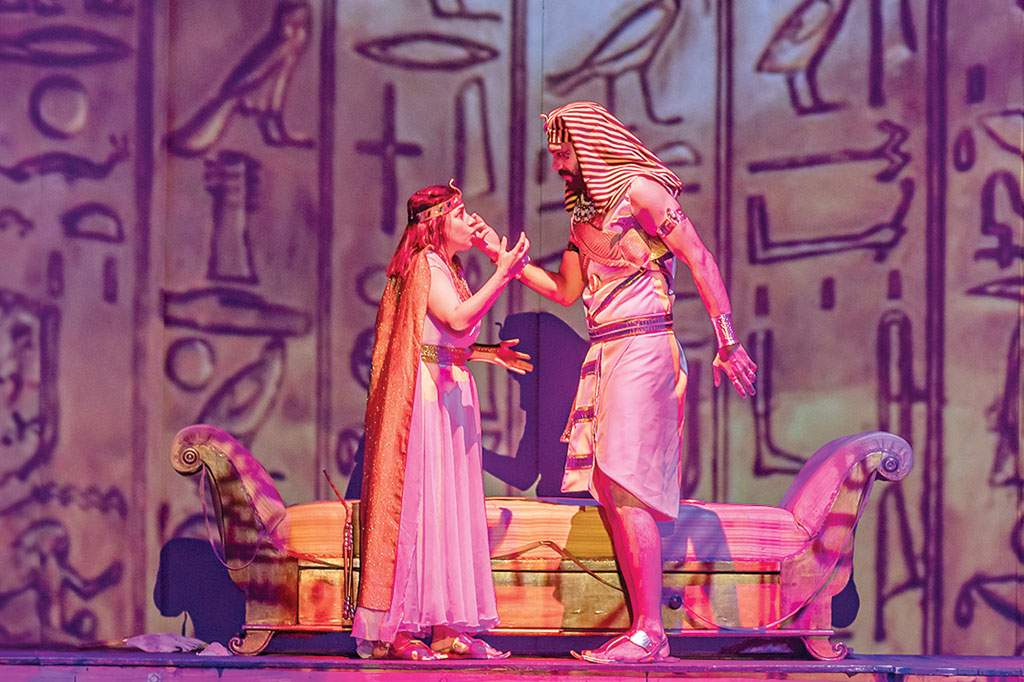
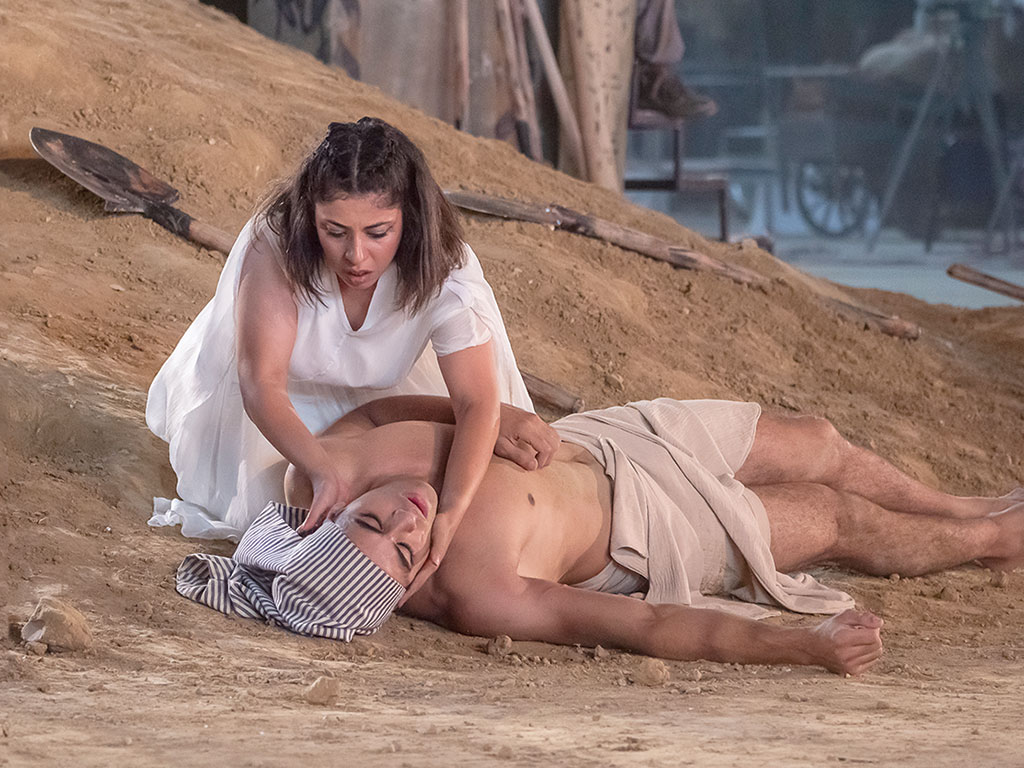
Editors: As far as the rendition of the Byzantine scene by the Istanbul group is concerned, what stood out was the subtlety in the interpretation of the religious controversies dividing Christianity. It is as if they approached the topic from the perspective of the ongoing Shiite-Sunni division present in the Muslim world, without any anti-Christian undertones. Opposition was to such an extent uncharacteristic of their mentality that Greek Orthodox liturgical chants even were included in their production.
A. V.: In my experience, the staging of space within The Tragedy poses the greatest challenge for directors. It is set in another spatial-temporal continuum, just like the scene in Heaven. However, the difference is also significant. While in the first scene, the angelic choir serves as the spokesperson for the creative idea and energy, and proclaims the goodness of the Lord, in space the ultimate physical endurance of human beings is tested, which no 20th-century advancements in space exploration have surpassed. That is one reason why the Georgians’ choice of genre was justified, as they transformed this scene into a dance drama. Above all, we must highlight the accomplishment of the soloist portraying Adam: the intensity of the movement he produced can only be achieved in an ecstatic state. The chorus serves as the springboard for this energy, and the initiation of its movement is reminiscent of choreography influenced by the Gurdjieff school. It is as if the chorus gives birth to and propels Adam, the “cosmic man,” out of itself. That is why we get the impression that this interpretation of the space is based on the interpretation of the entire Tragedy, which, as seen in Adam’s words yearning to return to the earthly realm (“I’m suffering, therefore I am – alive”), rhymes with the guiding motif of the second scene as well: “Life! Life! Sweet life! It’s good to be alive!” [3] It is not a coincidence either that the female figure portraying Lucifer also embodies, in a single form, the Spirit of the Earth, and if you prefer, even Eve herself.
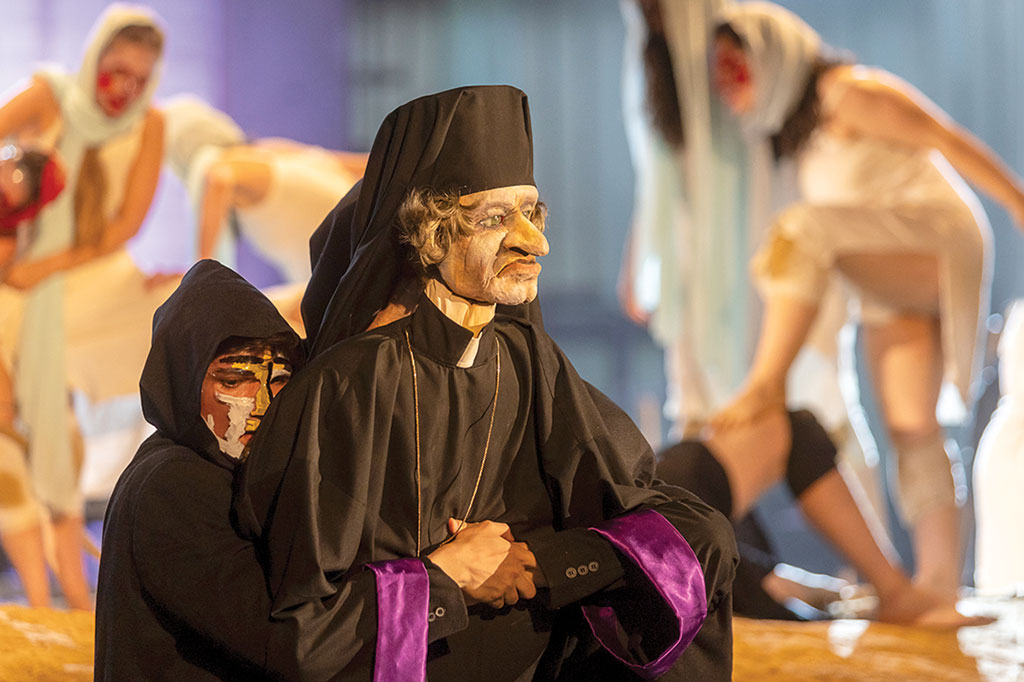
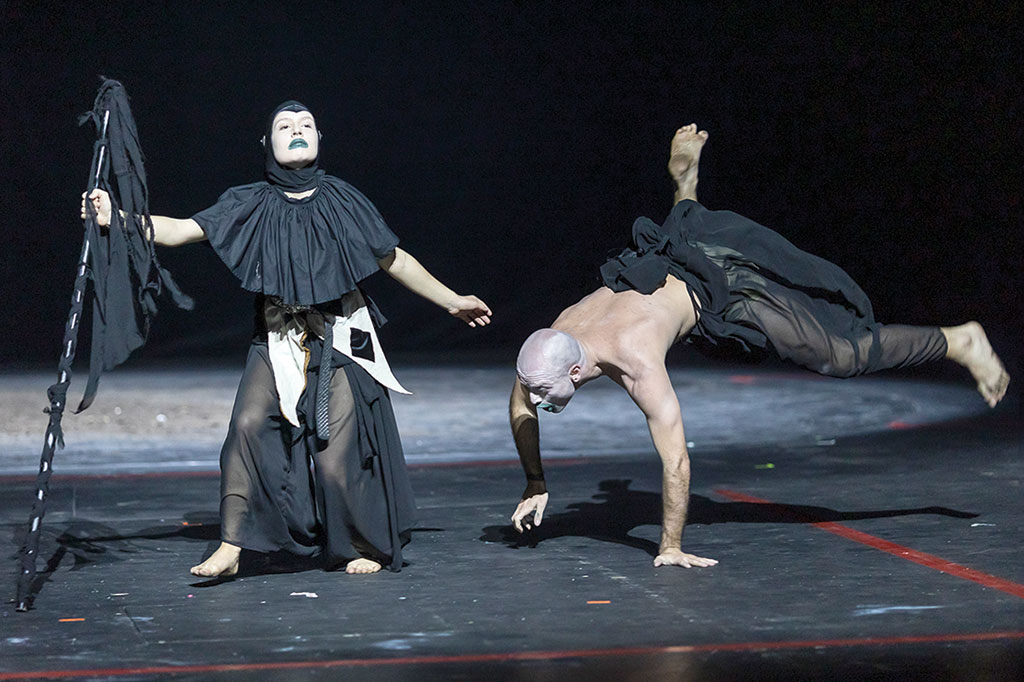
Editors: In the Athenian scene, Greek students simultaneously built upon the communal rituals and choral techniques of ancient tragedy, as well as contemporary Greek poetry, which infused their stage presence with a sense of personal connection throughout. It seems as if this interpretation of Madách’s work was the closest to the ideal of “poetic theatre” you represent. Do we see this correctly?
A. V.: The Greeks’ accomplishment served to me as a first and foremost example that in times of crisis, even “when the guns say”, the muses are not silent. Not even are they silent if funding is withdrawn from culture, as is the case in Greece now, where, as it transpired, the Odeion Athinum, the performing arts academy founded in 1871, has also been subject to demotion in status. The initial reaction of the drama students to this measure was to go on strike, and reportedly they even occupied their national theatre. However, the truly worthy response to this situation of the visiting company was the interpretation of the Athenian scene, cathartic even in its novelty. The members of the chorus as a kind of collective self repeatedly posed here the poetic question “where am I” directed towards the existential vulnerability of man, until they arrived with the answer in Madách’s ancient Athens, the scene of the dramatic action. Yet the story was not interpreted in the usual way, as a critique of ancient and modern democracies, but rather as the voluntary sacrifice of a victorious military leader accused of treason. Just as Madách himself suggests, when he puts the expression “a sense of comfort” in the mouth of his hero who is going to his death, implying redemption. “The Goddess heard you, Lucia. Farewell! / A sense of comfort wells up in my heart.” Man, as Theodoros Terzopoulos claims, inevitably suffers defeat against God and accepts death, but his “funeral procession continues in eternity as well.”[4] Madách’s Tragedy has, so to say, the Hungarian scene missing. However, when that particular archaic Hungarian folk song is unexpectedly sung by the young Greeks, we hear it as the apotheosis of our fallen struggle for freedom with a sense of profound emotion. It is as if these two nations were sharing common codes in antiquity…

Editors: In Madách’s Roman scene, the appearance of Apostle Peter is accompanied by cosmic-scale phenomena (see Madách’s authorial instructions: “With a great radiance the cross appears in the sky. Beyond the mountains the horizon is reddened by the flames of burning cities. Savage hordes are seen descending from the heights, and from the distance the singing of hymns is heard.”). Your current direction also has this shift in cult as one of its key points. What considerations led you to connect the Roman scene presented by the Italians with the Byzantine scene performed by the Turkish students, bringing together all the characters in a tableau that could be featured on a movie screen?
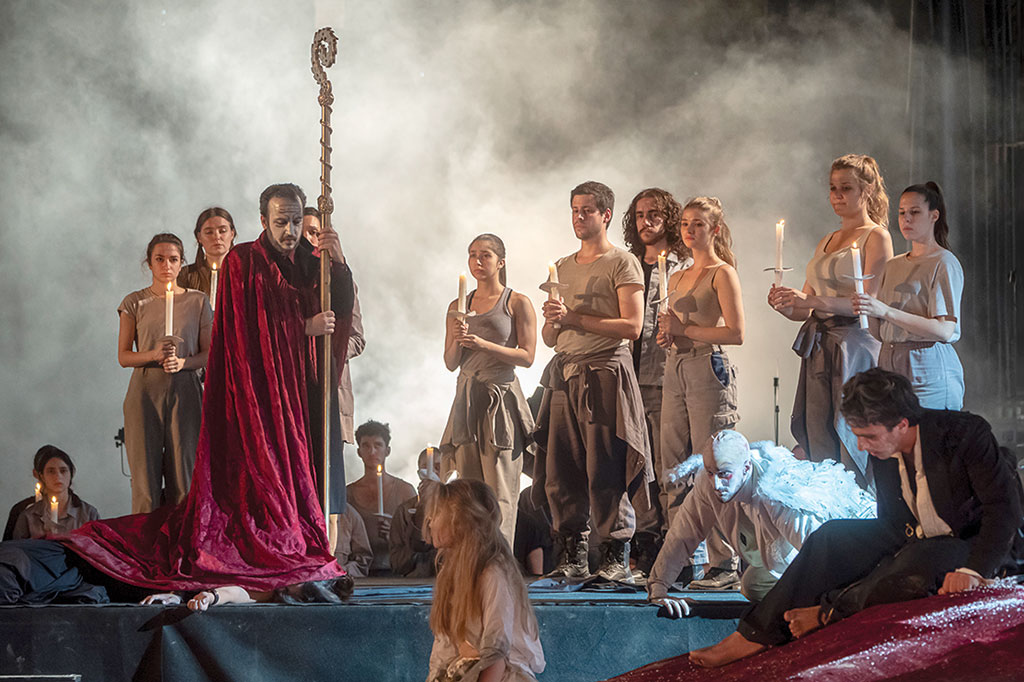
A. V.: I followed the way Madách composed the Roman scene, where a substantial part of the text involves the appearance of Apostle Peter, which is both a curse speech and an evangelizing sermon addressed to the characters of this scene, embracing the ideals of the new world era, promising the arrival of brotherhood and the liberation of the individual at the same time. Watching the Italian’s production, the question of whether Madách’s work is “The Tragedy of Man or Mankind?” may arise again. This direction[5] did not mean to portray the depravity of an empire in a naturalistic way. The mode of acting was characterized by a strong stylization reminiscent of commedia dell’arte. Lucifer did not make an appearance as a cynical game master, but rather played the role of Death itself as a white clown. And those motifs became prominent which distinguish in Madách also the duet of Adam and Eve from the other two couples immersed in physical pleasures. That is why it is not disturbing either that my directing colleague stripped the actors naked after the apostolic allocution was delivered. I only made one change to this, that in the final version presented, it is only Adam who sheds his old self: we see him in a fetal position, as the promise of the New Adam.
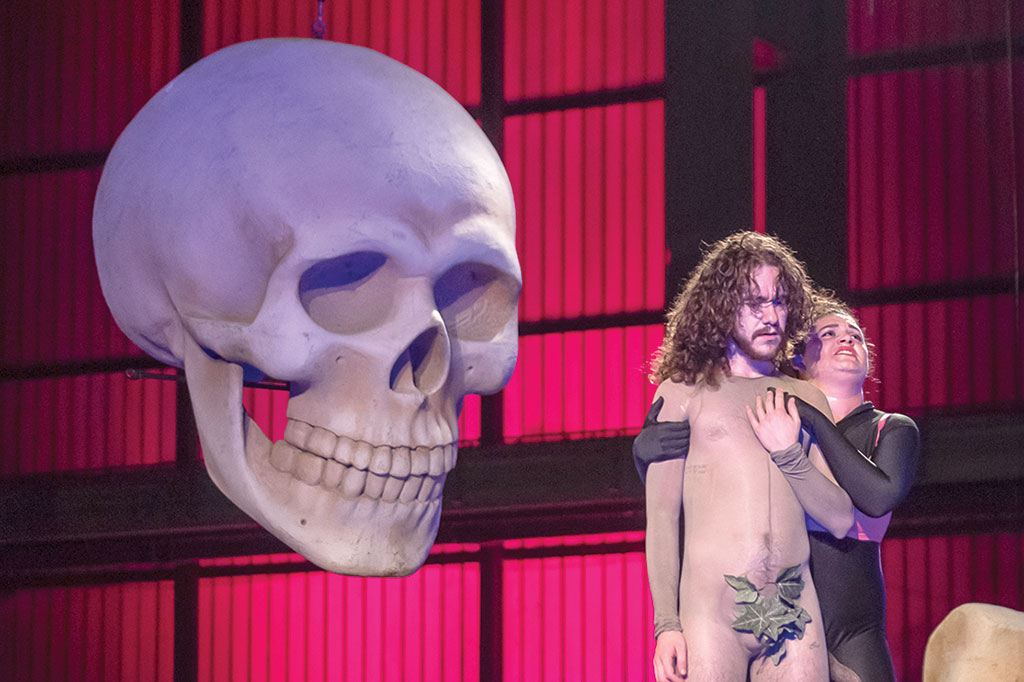
Turning to the Byzantine scene, it is important to note that only the Turkish participants used masks and puppets, emphasizing that this story unfolds on the border between life and death. That is why I decided to incorporate from my 2018 production the elements of the giant skeleton, with a strong emphasis on the skull, which dominates the stage from now on. With this, I also wanted to indicate that the beginning and the end, destruction and resurrection have a simultaneous presence in the Christian salvation story as well. By presenting the primal element of fire in two different ways and orchestrating the entrance of the crowd carrying candles and torches, I aimed to show the dual nature of Man – the longing for salvation and the elemental passion for destruction. As for the cinematic quality of this sequence, this impression could also arise from the very size of the hall. In this gigantic space, the use of natural light created the effect as if this ritualistic action took place at night, under the stars, opening up a new dimension for humanity.
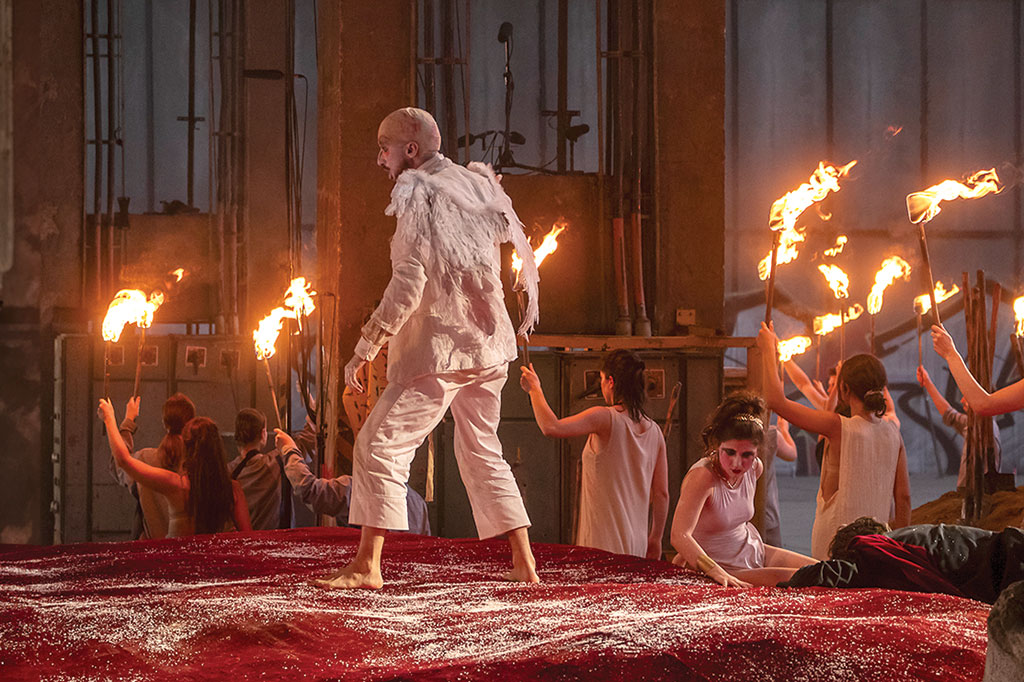
Editors: The English, the Canadians, and the two Romanian groups approached their chosen scenes from the perspective of humour. The most surprising one of them was the radical contemporary adaptation of the two Prague scenes and the Eskimo scene by the Romanians. Madách’s text was faithfully adhered to in the latter, too, but the performance itself was a female-dominated erotic farce: a triumph of sex, the victory of life force, through which the dying Adam was ultimately revitalized into new life. It is as if this elemental vitality was currently missing from Hungarian theatrical practice. What do you think is the reason for this?
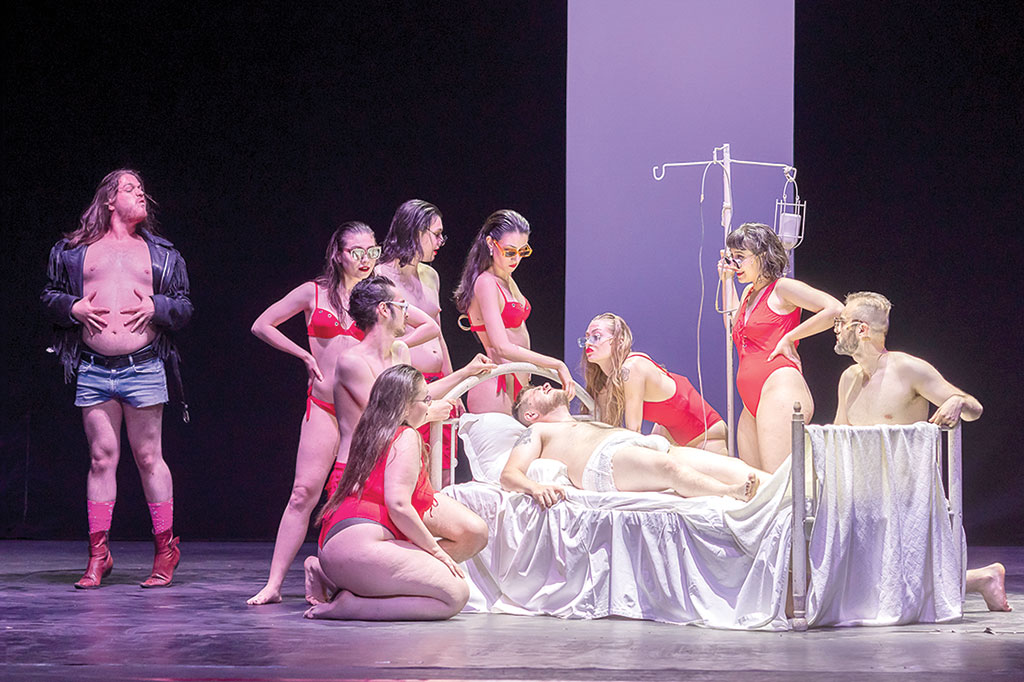
A. V.: Honestly, even I haven not been able to decipher it yet. And yet Madách’s work is quite suitable for parody as well. It is enough to think of Karinthy, the Hungarian master of humoristic literature, who was captivated by this work from his childhood and even published a concise, parodic adaptation of it in verse form titled Az emberke tragédiája [The Tragedy of Manlet]. The English and Canadians approached the London and Outer Space scenes with a similar attitude, holding up a distorted mirror to their own generation and their nation, simultaneously. Two renderings are worth highlighting specially: the game master of the Liverpool group, the female Lucifer, who with the harsh boldness and confidence of street performers, introduced and commented on the grassroots contemporary adaptation of this scene. In the episode by the Canadians that seemed to belong on a cabaret stage, the young man playing Adam appeared as if he was portraying directly Karinthy’s character, “Ádámka.” That is why I decided to incorporate this production as the puppetry segment in the London scene, employing the technique of “play within a play.”
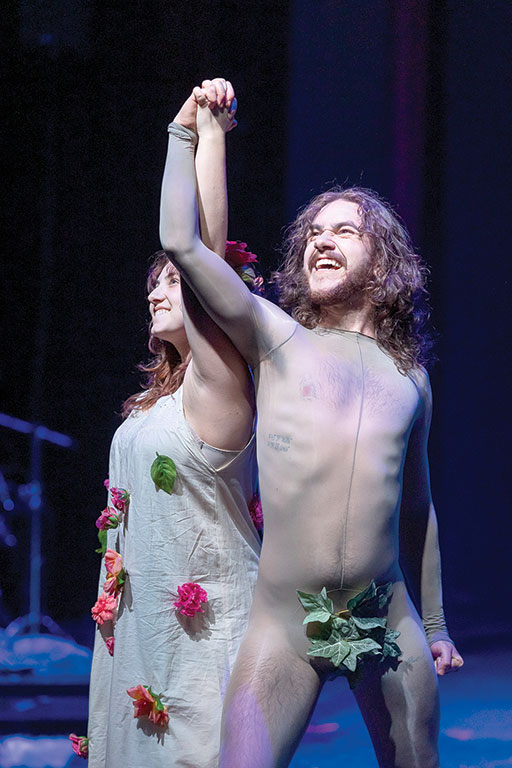
with two students from York University in Toronto
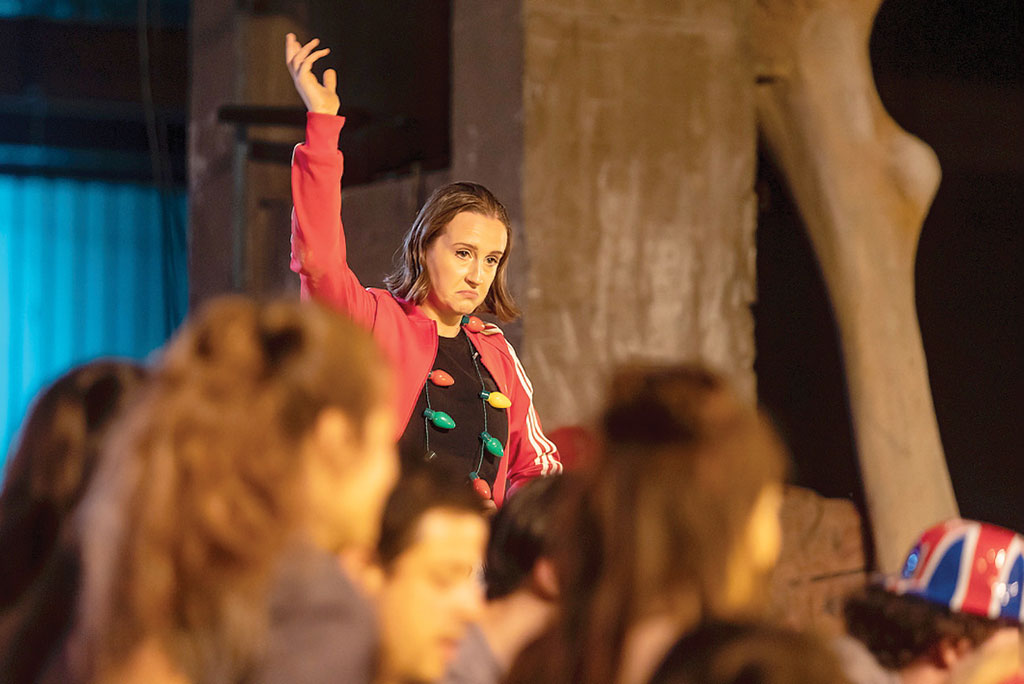
But let us not forget to mention the Parisian scene either, which the French presented in a traditional interpretation. However, they also introduced a grotesque character, the headsman, who constantly juxtaposed this linguistically sophisticated, classical performance style. I further developed this comedic element when I staged the revolution as a bloody carnival. The execution device borrowed from the National Theatre, which in the 2018 production served as both a printing press and a guillotine, in the final version not only executes the “children of the revolution,” but also chops watermelon heads. We must acknowledge that the idealised romanticism of the Parisian Revolution on stage has lost its relevance for today’s audience. The two enlosing Prague scenes in the interpretation of the Romanian participants are also not imbued with the type of resignation or disillusionment from the ideals of “progress” which we are accustomed to, where Kepler was made out to be the hero of his time as an un-understood scientist. The first Prague scene starts here with the comic dumb show of five androgynous courtiers, wearing male jackets and lace panties, all vying for the favour of Borbála. And from this point on, the side characters stand in the foreground and the female caricature of Emperor Rudolf dominates, pushing the conflict between the couple, Adam–Kepler and Eva–Borbála, into the background. I also preserved the Romanian-created stage design with its tripartite vertical and depth structure, so that it be sensed rather than seen that in the middle, where the virtual lines of force in the space converge, some kind of erotic act is actually taking place – whether it is adultery or the rape of the wife. I have never seen the psychological drama unfolding within Borbála so transparent as now, thanks to this young Romanian company. This was probably due to the fact that the spirit tempting her was here also embodied by a woman-Lucifer, who roamed through the entire space and took possession of it. Kepler’s homelessness was indicated by his inability to enter this active playing area. That is why I decided that he would occupy the farthest and highest suspended walkway in the hall with his giant telescope. And I also had him sketch out a child drawing featuring the sun, a little house and two trees, to portray his state of mind. Kepler descends to the second Prague scene only when the two ambitious teenage girls playing the roles of his male students approach him, demanding that he provide them with up-to-date, practical knowledge. Yet, no matter how humorously this scene comes across on the stage, it might remind us that the manner of transmission between generations is one of the greatest challenges of our times. The Prague scene does not ultimately boil down to this full-blooded, humorously exposed generational conflict. Borbála’s monologue, in which she once again laments the existential vulnerability of women’s fate, lends a tragic tone to this historical scene as well. As for the mentioned Eskimo scene, at first glance, it indeed stands farthest from Madách’s original vision. But if we take the entirety of the play as a starting point, as the Romanians clearly did, this interpretation does not seem so far-fetched anymore. It is possible that the fever dream they put on stage here is a continuation of that visionary state, which Adam had to undergo when he realized that after being expelled from Paradise, he now had to bear the burden of existence all by himself. “Remove this sight! This is insanity! / This fight, harassed by elemental forces, / tormented by the pangs of desolation… / Appalling, hideous predicament!” he cries out in the third scene. In reality, every personality destined for greatness experiences this shock at the pivotal moment of growing up, and not everyone survives this trauma. As for the dilemma of whether a sexual act occurred between Adam and Eve in the Eskimo scene, crucial evidence for this union could be Eve’s first words after waking up: “Adam, why did you steal away from me? / You seemed remote. Your kisses made me shiver.”[6] But how can this be brought to the stage? Perhaps indeed only with that full-blooded humour this troupe had, with the vitality and self-assured confidence that belongs to those in their twenties.
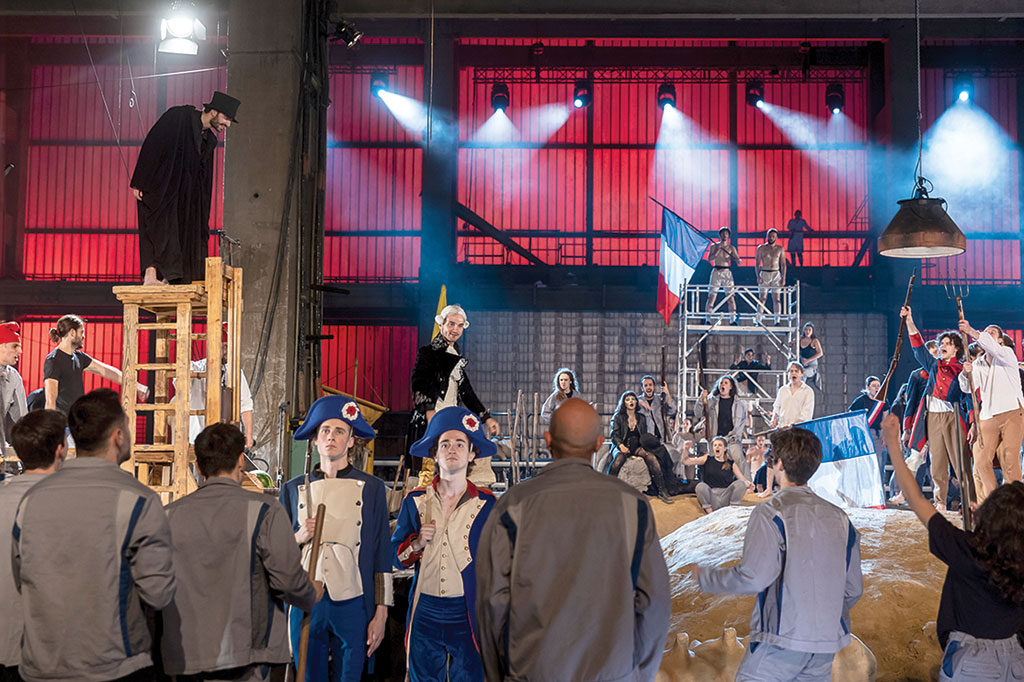
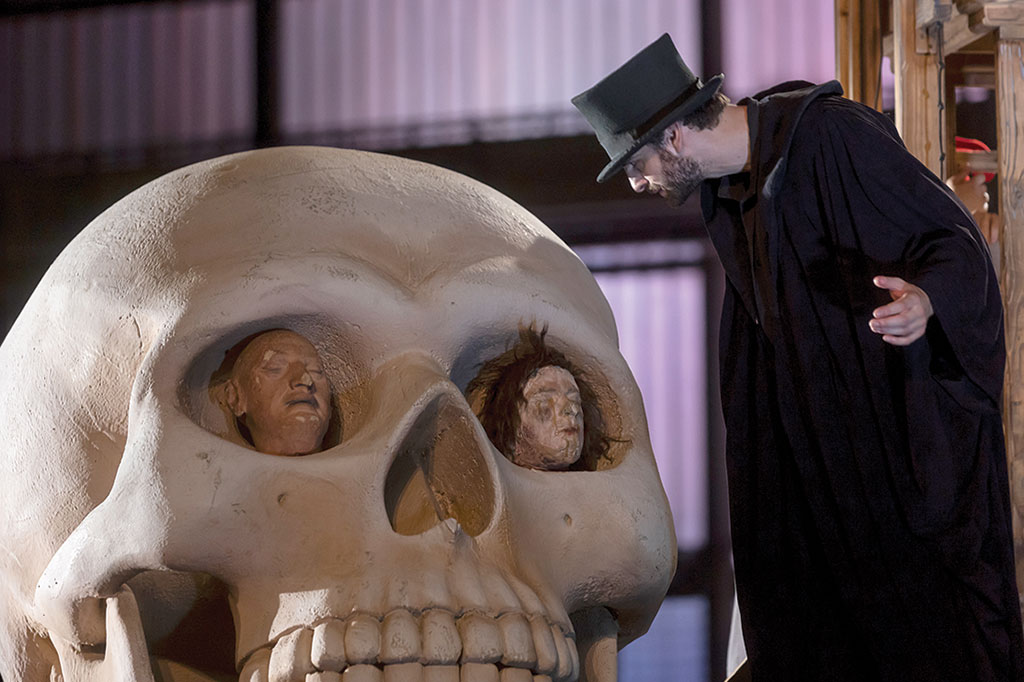
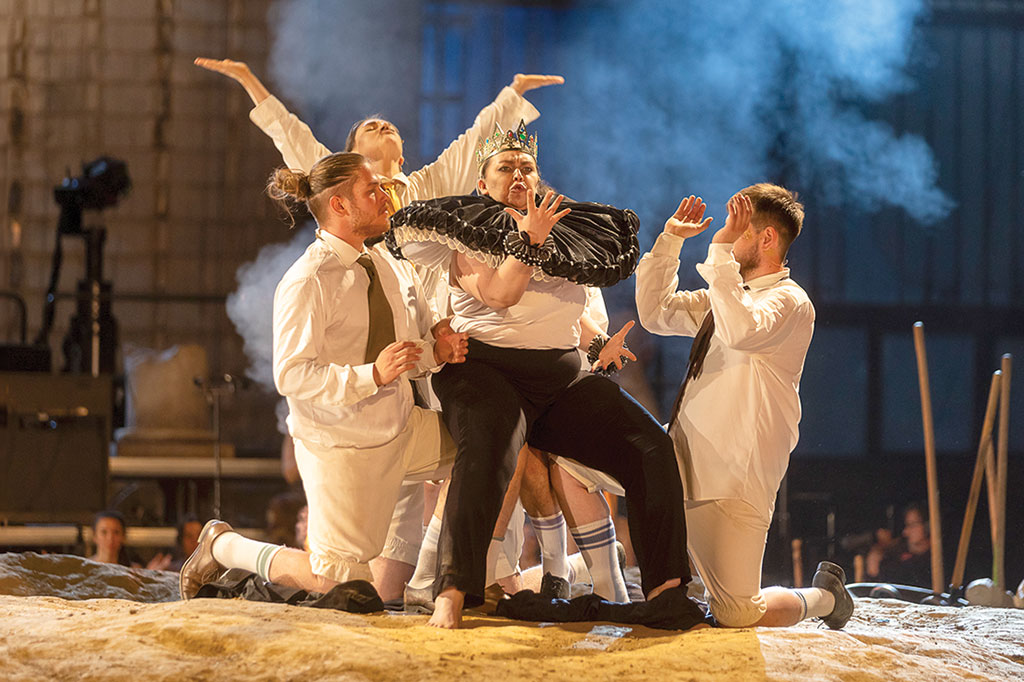
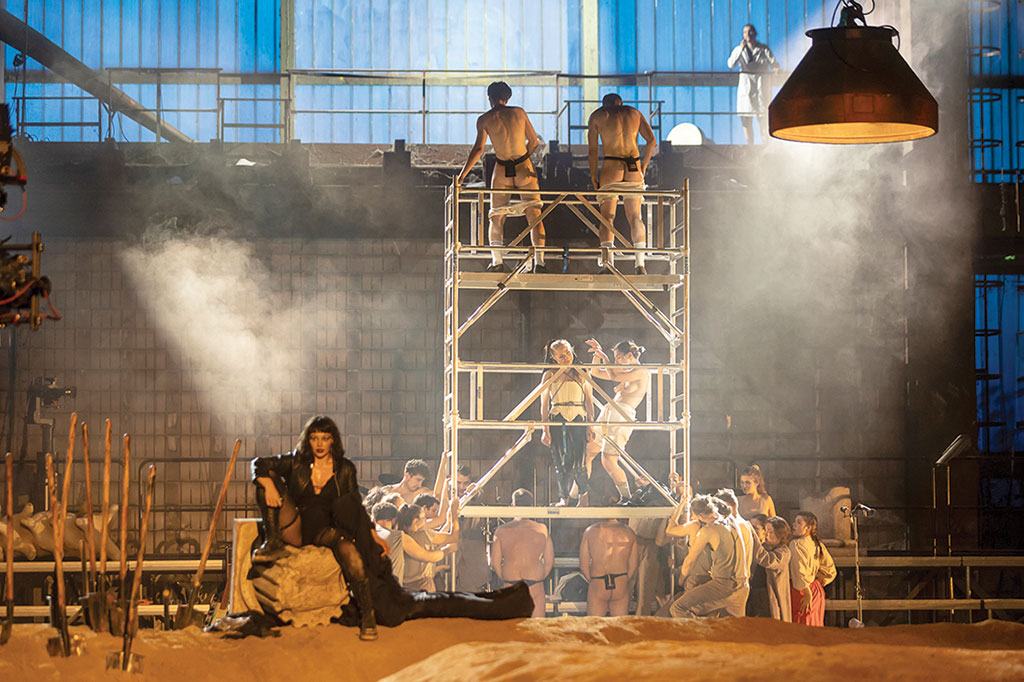
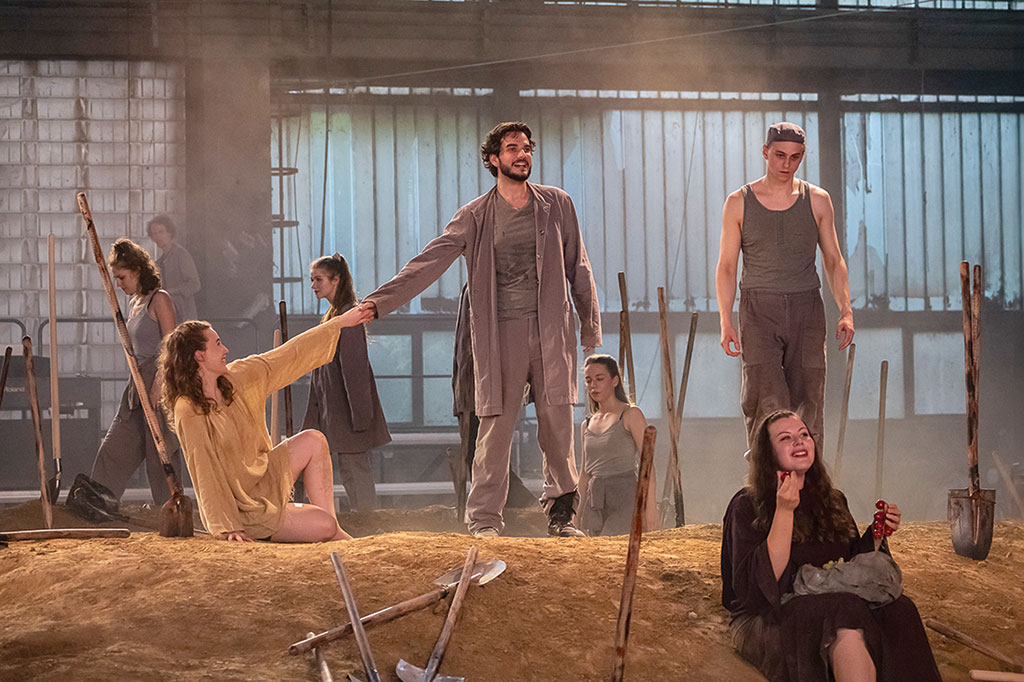
Editors: Just two weeks before the premiere, the Phalanstery scene was still not ready, so you had to take on the responsibility for it as well, along with the framing scenes. It could not have been easy to simultaneously evoke our inhumane, massified world with its Babel-like language confusion and, at the same time, conjure up a genuine celebration by the end of the ten-day gathering of these two hundred young people, conveying the sense that thanks to Madách, they managed to find a common language. How did this exceptional moment come about?
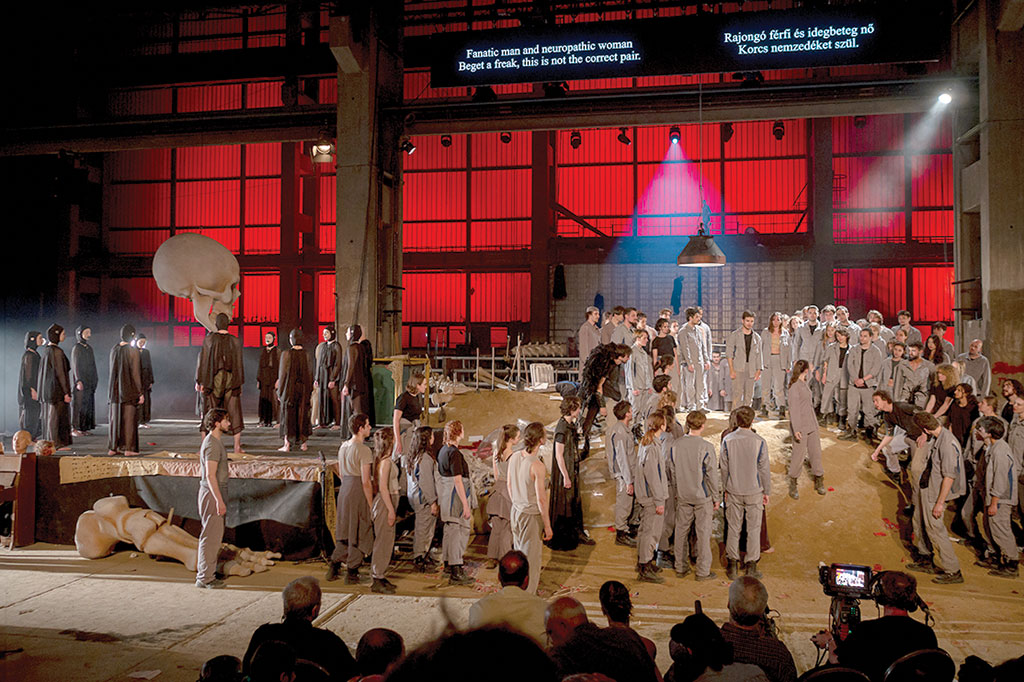
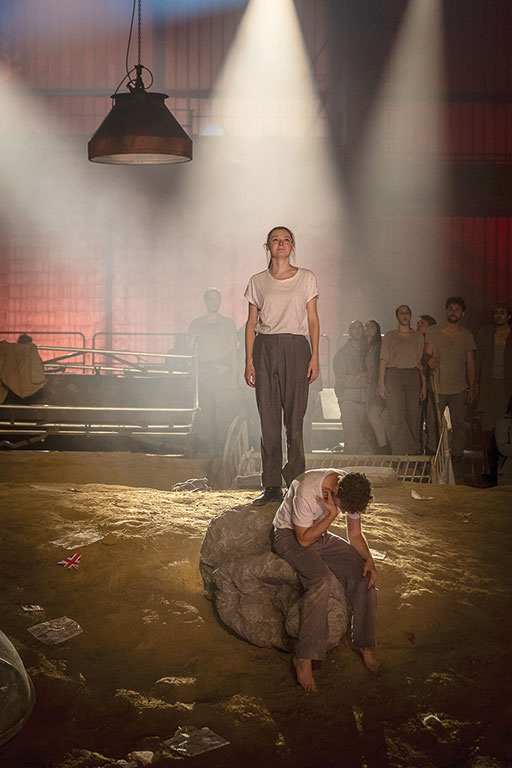
with the students of the University of Theatre and Film Arts in Budapest
A. V.: First and foremost, it is worth considering that in Madách’s work, the historical scenes culminate with the London scene. The following three – the Phalanstery, Outer Space, and Eskimo – scenes were negative utopias, nightmares of the future in Madách’s age. However, Phalanstery, along with Outer Space, has become a part of our everyday reality by now. This is why I decided that as early as in the Garden of Eden scene, the faceless, gray-clad mass should appear, and then the Fall should be celebrated by the entire cast, too. With this decision though, I had to let go of the portrayal of the first human couple’s naive, ethereal purity and innocence. I am sorry that I could not incorporate into the final version the Polish interpretation of the creation story, where the first human couple descends as the likeness of the Creator and hovers above the angels moving, building and wrecking the created world. Nor could I do this for the very reason that the technical conditions required for such presentations were not available at this location, unlike at the Eiffel Workshop House where the introductions had taken place. My great predecessor, Antal Németh, directed The Tragedy in Hamburg in 1937 with the intention of presenting it on a par with Faust to the cultured European audience. However, when he realized that the Germans viewed the Phalanstery scene as an open attack against National Socialism, he used Cyrillic lettering as a precaution so that this scene should explicitly refer to the Soviet Union. The Tragedy was banned from the stage in Hungary after 1948 due to its pessimistic tone and it did not change until 1954, when it was staged by the drama group of Madách Grammar School and performed seven times at the Small Hall of the Liszt Academy of Music. Back then it was an open rebellion against the prevailing conditions, and it had the support of some of the most prominent figures of the time, including Zoltán Kodály. I feel that once again, a young generation has set an example of how we can actively engage with the contradictions of our time. This is where the budding artists, their mentors, and the audience of this one-off performance came together.

Editors: Will there be a continuation of this international project? What benefits can this exceptional event have for the Hungarian participants and the entire Hungarian higher education in drama and theatre? The Madách Year is still going on: do you think this venture can promote a reinterpretation of The Tragedy of Man?
A. V.: As a stage director I do not perceive whether new literary interpretations of The Tragedy of Man will be formed in connection with this anniversary. However, I believe Antal Németh was right when, together with Álmos Jaschik, he advocated with his entire activity that the most active and important arena for the continuous reinterpretation of this Madách piece is the stage.
6 July, 2023
All the Madách project photos were taken
by Zsolt Eöri Szabó, source: nemzetiszinhaz.hu
Translated by Nóra Durkó
[1] The essay by theatre historian Nina Király (1940–2018) was published in Hungarian in the September 2018 issue of Szcenárium, and in English in the special MITEM English 2023 issue of Szcenárium.
[2] You can find Miklós Hubay’s commentary on the London scene and Eve’s miraculous rescue in his work titled Aztán mivégre az egész teremtés?, published by Napkút Kiadó in 2010.
[3] (The quotes from Madách’s work are taken from the English translation and adaptation by Iain Macleod, Imre Madách: The Tragedy of Man, Canongate Press, Edinburgh, 1993 in: http://mek.oszk.hu/00900/00917/html/)
[4] See Theodoros Terzopoulos, The Return of Dionysus, in Hungarian, University of Theatre and Film Arts, Budapest, 2023, p. 60
[5] The director of this scene was Sebastian Mattia, who as the head of ISCOT led the demonstration of the Suzuki training method at MITEM 2023.
[6] See for this the article by Ágnes Pálfi in Hungarian: A női éberség másállapota – Éva alakjáról Az ember tragédiájában, Szcenárium, September 2013, pp 29– 41; and in English: Ágnes Pálfi: The Pregnancy of Feminine Vigilance in The Tragedy of Man, Theatre Olympics and MITEM English, April, 2023, pp 97–104
(27 September 2023)











